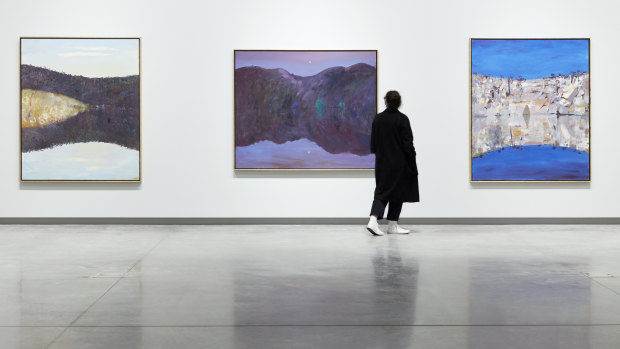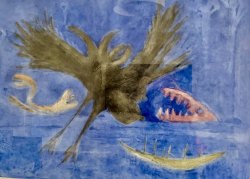By Julie Power
Wherever I’ve lived for the past 30 years, artist Arthur Boyd was there too. A hand-coloured lithograph that I call Arthur, bought with the proceeds of a freak Melbourne Cup win, has hung on the walls of my homes in Canberra, Sydney, Washington and Paris.
When I bought it, I was asked: “Will it match your furniture?” Ha. I didn’t own a house or any furniture back then, except a wonderfully awful gold couch, a street find that matched the equally delightful gold flock wallpaper in the house I was renting.
Called Magic Flute, Queen of the Night, the print, which originally had a beautiful gold leaf frame, features a cockatoo that seems to be coming to a screeching, swooping stop on the viewer.

Some of Arthur Boyd’s landscapes from 1984 are on show at Bundanon for the first time.Credit:
When I first visited Bundanon Art Museum and The Bridge, which opened in 2022, I looked for Boyd’s cockatoo-filled landscapes. Most of his work was corralled in the museum’s other site, where the old Boyd Homestead is packed with work by four generations of Boyds.
Like me, many visitors to the art museum are surprised by a lack of major paintings by Boyd who, with his wife Yvonne, gave the 1000-hectare wildlife sanctuary on the Shoalhaven River near Nowra and their $46 million art collection to the people of Australia.
That will no longer be the case. Bundanon plans to open a permanent Boyd Collection gallery space within the art museum this year. It will be designed by architect Kerstin Thompson, who won international and national awards for her design for the museum and the fireproof and floodproof Bridge, providing accommodation, that spans the gully.
Thompson said her continuing “fruitful collaboration” would expand the museum footprint from four to five galleries. It presented an opportunity to consolidate staff on the Riversdale site within “a new bespoke workspace that adds to the original Boyd cluster, and a new retail space for Bundanon editions and publications”.
Ultimately, about 500 square metres of gallery space across Bundanon’s two sites, the museum on the Riversdale Road site and the artist’s studio and historic homestead a 20-minute drive further west along the river, will be dedicated to the Boyd collection.
In 1993, the Boyds said they gave their home to enrich the lives of ordinary people with “the beauty, the history, the landscape, the environment” so they could be stimulated by artists and their work.
“He didn’t want all things Boyd,” Bundanon chief executive Rachel Kent said. “I always say to people, ‘It is a conversation between the legacy and the present’, which really supports his vision.
“A large part [of our visitors] come for the Boyd history and legacy. Another part comes for live programming, concerts, talks, hands-on workshops and so on. Others come because they want to see what artists are doing now.”
The plan will build connections between Bundanon’s sites, from the Art Museum to the Homestead and Arthur Boyd’s Studio, and support the exchange and loan of works between Bundanon and its national peers.

Detail from the Arthur Boyd lithograph Magic Flute, Queen of the Night that Julie Power bought after a Melbourne Cup win.Credit:
Kent said the art museum would continue to offer its annual program of three “seasons” of changing contemporary exhibitions.
The news coincides with the return of 14 landscapes by Boyd of the Shoalhaven River for the exhibition Wilder Times. Commissioned from Boyd in 1984 for Arts Centre Melbourne, it is the first time the paintings have been seen where they were created.
They are full of cockatoos, just like mine.
For visitor Christine Le Marseny, of Currarong, it has been wonderful seeing the Boyd landscapes in the art museum for the first time. “To see them in this kind of space is really lovely,” she said.
Le Marseny had “naturally assumed” the Boyds would be on show when she had visited before.
Steven Tonkin, a curator with Arts Centre Melbourne, said the landscapes by Boyd were originally conceived “as a secular cathedral to the arts”, with the artist reimagining Pulpit Rock, the craggy landmark on the river, to make it monumental.
Bundanon curator Sophie O’Brien described the works as a “hymn to the river, the rocky outcrops and the ever-changing natural world”.
Over the past decades, my Boyd print has been much appreciated by me, without appreciating in financial value. Wherever I went, Arthur gave a sense of home and place.
Sometimes I wonder what possessed a young broke reporter to spend so much money, about $3500, on a painting. I had nearly fallen out of love with the print until I stood near the bend of the river where Boyd had painted the series.
The feeling of joy in the landscape came back. “Good art stays with you,” Tonkin told me.
Wilder Times: Arthur Boyd and the mid-1980s landscape runs until October 13.